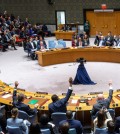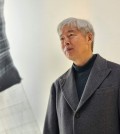- California Assembly OKs highest minimum wage in nation
- S. Korea unveils first graphic cigarette warnings
- US joins with South Korea, Japan in bid to deter North Korea
- LPGA golfer Chun In-gee finally back in action
- S. Korea won’t be top seed in final World Cup qualification round
- US men’s soccer misses 2nd straight Olympics
- US back on track in qualifying with 4-0 win over Guatemala
- High-intensity workout injuries spawn cottage industry
- CDC expands range of Zika mosquitoes into parts of Northeast
- Who knew? ‘The Walking Dead’ is helping families connect
More freedom in N. Korean truce village than expected: doctor
HWACHEON, South Korea, May 2 (Yonhap) — A humanitarian aid doctor who visited both sides of the tensely guarded border separating the two Koreas said he had more fun and freedom than expected during his travel to the northern side of the truce village.
John Linton, the chief of the Korea Foundation for International Healthcare in Seoul, has visited North Korea 29 times to build hospitals, and supply medical aid and food in major cities. Also known by his Korean name Yohan Ihn, the doctor holds dual citizenship of the United States and South Korea.
During his last visit to the reclusive state two years ago, Linton joined a guided tour to the truce village of Panmunjom within the Demilitarized Zone (DMZ), a 4-kilometer-wide strip of land running across the Korean Peninsula.
“Surprisingly, I had more freedom in the northern side of Panmunjom than the southern side,” Linton said during a recent interview with Yonhap News Agency. “I cracked jokes with North Korean soldiers, and even shook hands with them and took photos together.”

John Linton, the chief of the Korea Foundation for International Healthcare in Seoul, poses in front of a DMZ exhibition in the Seven Star Observatory in Hwacheon, just south of the border with North Korea, on April 29, 2016. (Yonhap)
The director of the International Health Care Center at Yonsei University Medical School in Seoul was speaking on the sidelines of a civilian workshop on DMZ tourism. The event was held April 29-30 at the Seven Star Observatory, located in Hwacheon, 118 km northeast of Seoul, which is guarded by the 7th Infantry Division of the South Korean Army.
The doctor, the great-grandson of the American missionary Eugene Bell (1968-1925) born and raised in South Korea, preferred to speak in Korean during the interview.
On the northern side of the military demarcation line, Linton and other tourists were given a briefing for five minutes that included Pyongyang’s version of the unfinished war: South Korean troops first crossed the 38th parallel to invade North Korea on June 25, 1950, a claim proven false long ago by the international community.
At Panmungak, the main building managed by the North Koreans in the Joint Security Area (JSA), Linton had a chance to see the House of Freedom, a venue for inter-Korean talks located 80 meters south of it. He also entered the northern side of a conference room where a truce agreement was signed on July 27, 1953.
Having visited the JSA on the South Korean soil, however, was not something the blue-eyed doctor had to hide from inquisitive North Koreans.
“They actually asked me first whether I had seen this area from the other side,” the 55-year-old said, with a laugh. “Because (North Koreans) have received so many tourists recently, they don’t care about such things.”
Some of the questions he received were “Didn’t they give tourists more guidelines than we did? Didn’t American soldiers tell you not to point a finger at us?”
Then they proudly told the tourist with the dual citizenship from countries Pyongyang considers as its enemies: “We are free as you can see. We don’t have such instructions.”

South Korean soldiers guard the Joint Security Area in the truce village of Panmunjom on Sept. 25, 2015. (Yonhap)
Before being allowed to enter the DMZ from the southern side, tourists also receive instructions on the guided tour and must sign a document that warns of “a possibility of injury or death as a direct result of enemy action.” There have been various incidents in and around the DMZ, with military and civilian casualties on both sides decades ago.
The fourth-generation member of a renowned U.S. missionary family has deep knowledge of Korean history and culture, but he could see the grim reality of the divided nation during his first border crossing of the North Korean border with China in 1997.
“I realized that there is another Korea, and it didn’t feel right,” he said. “I was wondering when the two Koreas would become one.”
During a train ride from Dandong to Sinuiju, Linton saw a group of North Korean kids playing near the Yalu River. That scene evoked a sense of nostalgia of his early days in Suncheon, a southwestern South Korean city he considers as his hometown.
“The scene was very touching because I played with other kids like that 40 years ago,” he said.
Though he opposes Pyongyang’s communist ideology, the doctor sympathized deeply with North Koreans suffering from hunger and human rights abuses under the Kim Jong-un regime.
Linton, however, positively evaluated Pyongyang’s move to boost tourism to earn hard cash, seen as an attempt to circumvent the strict international sanctions imposed on the already impoverished state.
North Korea welcomed 100,000 visitors in 2014, mostly from neighboring China, and aims for 1 million tourists by 2017 and 2 million by 2020.
“I think tourism is the most effective way to bring changes to the North,” he said.

This photo taken on April 29, 2016, shows a South Korean Army guard post just south of the military demarcation line. (Yonhap)
When sour inter-Korean relations thaw, Linton hopes to see young South Koreans travel not just to border areas but also to inner tourism destinations, such as the Masikryong Ski Resort and Wonsan.
The Masikryong Ski Resort is North Korea’s only ski resort built in 2014, which is located some 20 km away from Wonsan, a port city and home to the North Korean navy.
Seoul halted an inter-Korean tour program to Mount Kumgang on the east coast following a 2008 shooting death of a South Korean tourist by a North Korean soldier. The Kaesong Industrial Complex, a joint industrial park in the western North Korean city, was also shut down following the communist regime’s fourth nuclear test in February.
“I personally want to see South Korean college students take a bus to the Masikryong Ski Resort and even travel deeper in such regions as Wonsan, which is more open to foreigners,” he said. “If youngsters are allowed to travel in North Korea, it would help provide a breakthrough in relations between the two Koreas.”
Although travel to the heavily fortified area offers a unique experience to visitors from around the world, he said, the divided peninsula is “a serious and scary reality” for families who remain separated since the end of the war.
The doctor wished that South and North Korean officials meet in the near future to discuss cross-border exchanges and humanitarian projects, proposing expansions of DMZ tour programs as a way to ease tension in the border area.
“Militaries are confronting each other, but I see little chance of North Korean soldiers hurting civilians visiting here,” he said. “If more civilians enter this area, it would help ease tension.”











